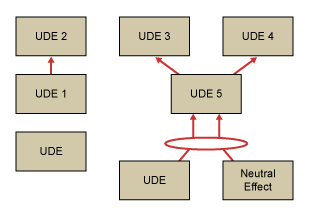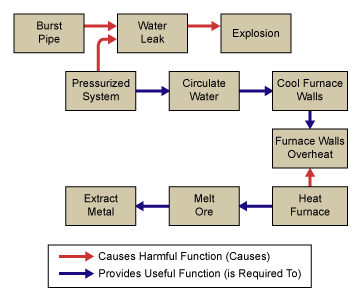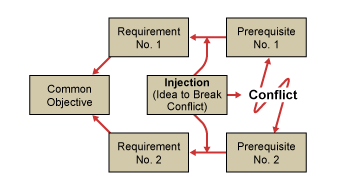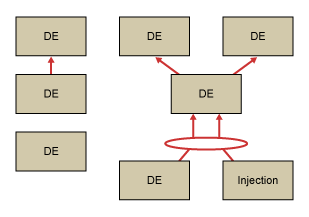
The theory of constraints (TOC) is relatively easy to understand. It is a philosophy of management based on the idea that to improve a system or process one must find and address the one aspect of the system that most limits the entire process from being optimum. But getting from the theory to application is not necessarily intuitively obvious.
By exploring the tools of the theory of constraints Six Sigma practitioners to apply the theory. The five tools to be discussed are:
- Current reality tree
- Conflict resolution diagram
- Future reality tree
- Prerequisite tree
- Transition tree
Current Reality Tree
A current reality tree (CRT) is a type of flowchart that depicts the cause-and-effect relationships that exist for the object of interest. The tree is normally built starting with a listing of effects to be remedied. The contributing factors that perpetuate these effects are associated with them are listed accordingly. The type of analysis is performed again on the perpetuating factors and is continued again what in essence would be the root cause.
Here is how to build a conflict resolution tree: Identify three or four people as team members and develop a list of 10 undesirable effects (UDE) that affect the current reality. The UDEs are written in present tense. For simplicity, this example will be limited to five as shown in Figure 1.

Ask the team if any of the UDEs are the cause or effect of another. If so, arrange them so the causes are at the bottom and the effects at the top. This is illustrated in Figure 2.

UDE 1 is a cause of UDE 2, and UDE 3 and UDE 4 are both an effect of UDE 5. Arrows are used to indicate the cause-and-effect relationships. It is possible to build down from these symptom problems to the deeper underlying causes by adding more UDEs or may be even neutral effects. Figure 2 shows UDE 5 is an effect of an underlying UDE and a neutral effect. These two entities are the cause of UDE 5 and this is shown by the use of ellipse.
Conflict Resolution Diagram
Inevitably when one begins to take a look at an undesirable condition of any kind, some issues that need to be addressed will be unearth. More often than not these issues will have competing interests within the organization that inherently conflict with one another. For example, the root cause of accidents on a street corner may be that people cannot see the stop sign that is covered by the branches of a tree. The tree has overgrown because there is infighting between the city street department and the parks and recreation department. Each claims that the other has responsibility for the maintenance of the tree and neither has actually done anything. Thus, the undesirable condition of a tree blocking the visibility is what needs to addressed. The desired activity would be clearly visible stop sign.
An example (Figure 3) that involves the design a furnace and the desire to avoid a particular problem associated with the cooling system may provide some clarity.

Contradiction identified: Pressurized system should exist to circulate water and should not exist in order to avoid water leak. The proposed solution to this problem emerges from challenging the need to have a pressurized system. The use of a vacuum pump identified as a way of breaking the contradiction. This explanation gives a flavor of a conflict resolution diagram (CRD).
The steps in the process of constructing a CRD are:
- Articulate the conflict
- Determine the requirements
- Identify the objective
- Polish the diagram
- Expose the assumptions and identify the invalid
- Create injections to replace one or both prerequisites
CRD consists of five elements: a common objective, two non-conflicting requirements and two conflicting prerequisites/assumptions.

Future Reality Tree
Using the current reality tree, the existing conditions that needed to be changed are identified, then using CRD, the objective to counter the effect of root causes are identified. At the core of this plan of attack is the injection, which if followed assures the path of success. With the future reality tree (FRT), it is possible to develop a more detailed analysis that considers what may or may not happen at each step along the way toward the expected outcome.
In structure, FRT is similar to CRT but with new proposed actions, policies and behaviors injected into it in order to create a new vision of the future reality of the system. At its simplest, all the undesirable effects of the CRT are changed to desirable effects (DE). The FRT is illustrated in Figure 5.

The presence of the new idea or ideas as injections will change reality from undesirable outcomes of the present to desirable outcomes of the future. Several different injections may be needed to achieve this.
FRT is the tool of choice in gaining understanding and agreement that the solution decided upon will account for all the undesirable effects that are currently experienced and built into CRT.
Prerequisite Tree
The prerequisite tree is a tool that can used independent of the other tool in the theory of constraints. Its purpose is to help identify obstacles that exist between the current state and desired objective. It offers a means for determining an approach for overcoming obstacles. It is possible that a prerequisite tree may not be necessary for a simple objective that previously has been discussed with CRT, CRD and FRT.
Every year, thousands of participants dive into the Pacific Ocean in Hawaii to start a race. The event consists of swimming 1.2 miles, jumping out of the water and bicycling 100 miles, and hopping off the bike and running 26.2 miles. The ultimate objective of most participants is completing the event, but for a few the objective is to win the race. Within each part of the race are other objectives. In the first leg of the event, participants need to try to keep the salt water out of their eyes, avoid sharks, etc. Once on their bikes, they need to assure that their bikes perform as expected mechanically throughout and need to know what to do if they get a flat tire, etc. And the same is true for the marathon run at the end.
To successfully achieve an ultimate objective, one must set intermediate objectives and overcome the specific obstacles to those objectives. The prerequisite tree is a compilation of these intermediate objectives and their associated obstacles.
Transition Tree
The transition tree is similar to the future reality tree with the exception of couple of key points. The transition tree is intended to be used for a final implementation plan. Whereas the FRT is used as a planning tool to help simulate what might happen in practice when certain actions are initiated toward achieving a desired outcome. The transition tree is used when one has completed their simulation activity and is ready to go forward with a plan. It is basically another project management planning tool.
| Comparing Theory of Constraints and Six Sigma | |
|
Theory of Constraints |
Six Sigma |
| Works primarily at the level of the chain, driving focus to the weakest link and then to the linkages between that constraint and other aspects of the system. | Works primarily at the level of a local link of a systems chain and its interaction with its immediate supplier and customer processes. |
| Uses logic-based tools. | Is data based. |
| Approach to root cause analysis is based on the tools outlined in this article. | Uses traditional quality tools for problem solving. |
| Focuses on building logistical processes that are robust enough to deal with current variation. | Focuses on minimizing variation. |
| Extends its use of the constraint to define maximum value for a market segment or customer in terms of the constraint or core problem of their system. | The value to the customer is closely tied to assuring that products and services delivered meet or exceed specifications or requirement of those outputs. |
| For continuous improvement, uses the five-step process: identify constraint, exploit, subordinate everything else to the constraint, elevate the constraint, go back to Step 1. | For continuous improvement, uses DMAIC (Define, Measure, Analyze, Improve, Control). |
Despite commonalities and criticisms of all improvement methodologies, the ultimate objective of using these methodologies is the same: To solve a problem.